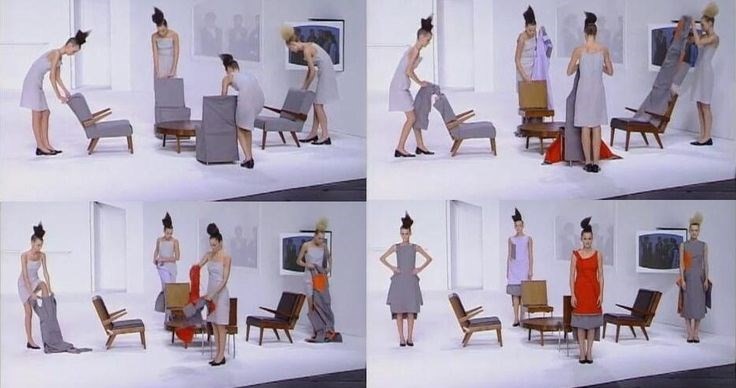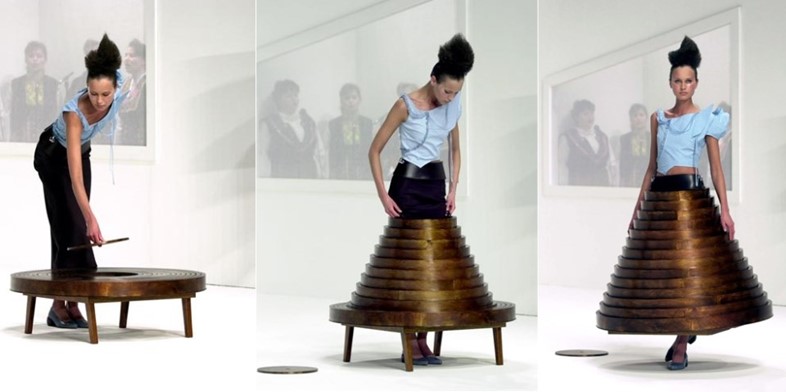We look back to A/W00, when the avant-garde designer staged a DIY happening with impeccable finesse – and turned a coffee table into a dress
"I feared things going wrong, but the risk was so worth taking," said Hussein Chalayan shortly after his A/W00 show. If anything qualifies as a risk, it’s transforming a piece of furniture made from wood into a piece of clothing – and all in front of a live audience. That’s what Chalayan did at London Fashion Week in February 2000: he transformed four chair covers and a coffee table into four dresses and a wooden skirt.
Drawing on themes as disparate as architecture, aerodynamics, space and religion, Chalayan has earned a reputation for being London’s cerebral designer, marked by his unique talent for combining philosophical ideals with wearable clothes. He rose to prominence in the 1990s, heralded by the Guardian’s then-deputy fashion editor Charlie Porter as a "leading light of the reinvigorated London fashion industry," positioned alongside fellow Central Saint Martins graduate and designer Alexander McQueen. "He raises daily life to a level of something magical. He was born with these powers…" commented Icelandic star Björk, with whom Chalayan collaborated throughout the 1990s. Today we look at Chalayan’s powers, and specifically how they manifested in his renowned furniture show back in February 2000.

The Show
On a stage that resembled a living room – complete with four chairs, a table, a flat screen television, several vases and pots – the designer presented his collection to press and buyers. This show bordered on a 1970s "happening": four models wearing grey shift-dresses approached these chairs, removed the covers and then put them onto their bodies. The last model wearing a similar dress delicately stepped into the middle of the table, lifted it up and transformed it into a skirt. Needless to say, the audience broke into rapturous applause.
This wasn’t, however, an exercise in theatricality for the sake of theatricality – this is Chalayan, fashion’s "storyteller" after all. The show was inspired by refugees of war, people forced to flee their homes, carrying their worldly possessions on their backs. Given the designer’s Turkish Cypriot heritage and the conflict that occurred in that area during the 60s and 70s, this inspiration has a particularly personal resonance – and it was dealt with sensitively. "Everything was deftly handled from the Turkish theme, used for a background choir, to coats with built-in mitten pockets and the quirky ending..." wrote Suzy Menkes in her show report for The New York Times. "It was a stellar performance."

The People
Futurism and minimalism are tropes that have marked Chalayan’s approach to fashion design, and this collection was no exception. Models including Erin O’Connor and Devon Aoki wore simple clothes in a palette of primarily black and tertiary colours. They looked, according to Vogue’s show report, "Like millennial (and amazingly chic) nomads, they wandered the stage in stiff black dresses inspired by Christian Dior." As for their hair, it was clipped topiary-like into shapes that resembled elaborate fascinators. Chalayan sees the body as a structure around which clothes are designed to "cocoon" – something that took on a very literal meaning during the finale.

The Impact
While this was by no means a watershed moment in the designer’s career – Chalayan was already widely respected for his innovative approach to fashion and its presentation – it is, to this day, celebrated as one of the greatest moments in 90s fashion, and further cemented his reputation as one of Britain’s finest creative talents. This was acknowledged several days after the show when Chalayan was presented with the British Designer of the Year award at the British Fashion Awards – for the second year running. He used his acceptance speech as a soapbox to call the press to celebrate creativity not celebrity, pointing a rather direct finger at pop-singer-turned-designer Victoria Beckham (then quite new on the fashion scene). "All the designers just work so hard; they deserved that space more than Posh Spice," he said. "Sometimes, this country is all about celebrities and football and pubs. I thought the fashion press might have been able to transcend that, but obviously the papers asked them to report on whatever was apt." His erudite nature – of which this was a prime example – was picked up by Cathy Horyn who wrote in a 2000 review, "Mr. Chalayan is famously aloof, and at times his comments add up to mumbo jumbo, but there is nothing vague about his talent. It punches you in the nose with its audacity, and makes you feel grateful for the blow."
Though Chalayan has often pulled off manoeuvres of seemingly fearless risk-taking, he’s always followed them through with technical brilliance. Whether it’s his use of meticulous pattern cutting or more recently with the water-soluble fabrics employed in his S/S16 collection, he balances concept and execution, philosophy and wearability, theatricality and technicality deftly in equal measure.